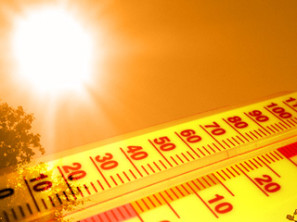Summer’s hot. And as you get hot, your performance drops. Here’s the how and why, and how to keep your cool.
Human temperature regulation processes maintain a core body temperature over a very narrow functional range despite elevated metabolic rates and exposure to very hot environments. During submaximal exercise, we can limit the effects of the increased heat production through sweating and evaporative cooling. But as intensity climbs, our ability to offload heat becomes limited; in conjunction with a hot/humid environment; we are most likely going to experience hyperthermia. Technically, heat stress and hyperthermia are the overarching umbrella terms for heat illness (heat exhaustion, heat stroke), and are identified as an elevated body temperature due to failed thermoregulation that occurs when the body produces or absorbs more heat than it can dissipate.
During exercise in the heat, the most significant physiological burden is supporting blood flow to the skin: high skin blood flow is needed for heat dissipation. (The average blood volume of an adult male is ~5 liters, and the average female ~4.4 liters, not much to go around!). We often think of a high core temperature as being the limiting factor for performance; eg the “critical core temperature”, but it is more the temperature of the skin that affects aerobic performance. Skin temperature is highly influenced by the ambient temperature and humidity, whereas the core temperature is influenced by the intensity of the exercise (which is partially why a power decline is seen with elevated internal temperatures). Warmer skin induces a greater amount of skin blood flow, decreasing blood volume available for circulation. For example, with a sustained elevated core temperature, an increase in skin temperature will have a concomitant increase in heart rate but the reverse is also true- cooling the skin even with a sustained elevated core temperature will reduce heart rate due to more blood shunting back into circulation(1).
During combined exercise and heat stress, hypohydration (low body water, aka dehydration) increases the effects of hyperthermia and cardiovascular strain in proportion to the amount of body water lost. Why? It comes back to blood volume: with less water in the blood; there is less total blood available per heart beat. This reduced-blood volume scenario also contributes to a higher heart rate (as the heart is trying to maintain total circulation and blood available for muscular work), and as the volume drops, it becomes more difficult to sustain muscle blood flow and thus power output in the heat. This phenomenon is often seen as “cardiac drift”- elevated heart rate with decreased power output.
“Okay, so how does this really affect me when I’m training or racing in the heat? Since it is a physiological mechanism, what can I really do to help my performance?”. There are several factors to consider here. First there are the longer term factors of short term heat acclimation, and second are the acute “on-the-day” factors.
Short-term heat acclimation (STHA):
The benefits of heat acclimation are plentiful and are primarily illustrated as a decreased heart rate and greater blood flow at a set workload in the heat. Underlying benefits include a reduced rise in skin and core temperatures, more dilute sweat, with an earlier onset of sweating due to an expansion of plasma volume. Basically you increase your total blood volume, and have a reset baseline of your thermoregulation responses (making 100’F feel like 70’F…). Riding in the heat of the day is one way to acclimate, but you compromise the training and fitness adaptations until you become accustomed to the heat. A more aggressive approach, (one which does not compromise training) is to use permissive dehydration and passive heat stress. “Permissive dehydration” occurs with exercise in the heat, in that fluid intake cannot meet the demands of fluid loss. This mild, but unavoidable dehydration (~2%) is a stress that enhances heat acclimation responses. Note, this level of dehydration is not enough to impair health or performance, and a greater amount of fluid loss does not enhance the heat adaptation response. The combination of slight dehydration with passive heat stress (sauna) can elicit heat acclimation within 5-6 days (2, 3). For example, using the sauna, post-training, with a slow rehydration protocol or specific fluid restriction in a hot yoga class with a slow rehydration protocol can garner the STHA responses desired.
On the Day:
The primary concern on a hot day is to maintain blood volume, and to reduce compromised circulation to the skin, muscle, and brain. There are several strategies to attain this. First is to consider using a prehydration/hyper-hydration strategy. The initial hyper-hydration work stems from NASA and Dr. John Greenleaf (5), who were looking to expand plasma volume in astronauts coming back from an antigravity state (no gravitational pull reduces plasma volume to a point where standing up becomes difficult). Using a combination of sodium chloride, sodium citrate, and water, this sodium+fluid load improved plasma volume by 11-20%. Additional research in athletes has demonstrated this sodium+fluid load improved plasma volume expansion and subsequent performance in the heat (6, 7). This strategy increases water available in the blood for circulation and sweating. To add to this hyper-hydration strategy, maintaining a solid hydration plan during the sessions is critical. The goal is to slow down the rate of total body water loss, which slows the rate of blood volume loss.
The second strategy is to consider the temperature of what you are drinking. By hyperhydrating with a cold (almost slushee-like) drink and consuming as much cold stuff on course as possible (pre-freeze your drinks!), will tap into the concept of “enthalpy of heat”- where the cold ingested absorbs body heat, akin to evaporative cooling (4, 8).
The third strategy is to consider skin temperature; by reducing skin temperature, you will maintain more effective blood volume (see the opening discussion of this article). One thing here, do NOT put ice against the skin- the gradient of ice cold against warm skin is counterproductive: it elicits a strong vasoconstriction response, increasing heat storage driving core temperature up (contributing to the denaturing of contractile proteins of the muscle and central nervous system fatigue). Cool water against the skin works, and manipulating the microclimate against the skin by using damp cooling fabrics (comprised of silver fibers and specific construction).
The combination of blood volume elevation and cooler skin will maximize effective circulation, allowing for a sustained power output for a longer period of time.
 Stacy Sims, MSc, PhD, served as an exercise physiologist and nutrition scientist at Stanford University specializing in recovery and nutritional adaptations for health, body composition, and maximizing performance. During the past decade she has worked as an environmental physiologist and nutrition specialist for top professional cyclists and triathletes, ultra-endurance athletes, the Garmin/Slipstream Pro Cycling Team, USA Cycling Olympic Team (BMX and women’s track cycling), Team Tibco, Flying Lizard Motorsports, and Team Leopard-Trek, among others. She competes as a Cat 1 road cyclist and elite XTerra triathlete and is co-founder of OSMO Nutrition.
Stacy Sims, MSc, PhD, served as an exercise physiologist and nutrition scientist at Stanford University specializing in recovery and nutritional adaptations for health, body composition, and maximizing performance. During the past decade she has worked as an environmental physiologist and nutrition specialist for top professional cyclists and triathletes, ultra-endurance athletes, the Garmin/Slipstream Pro Cycling Team, USA Cycling Olympic Team (BMX and women’s track cycling), Team Tibco, Flying Lizard Motorsports, and Team Leopard-Trek, among others. She competes as a Cat 1 road cyclist and elite XTerra triathlete and is co-founder of OSMO Nutrition.
Suggested Reading:
1. Sawka, Cheuvront, and Kenefick. High skin temperature and hypohydration impair aerobic performance. Exp Physiol 2012; 97(3):327-332.
2. Garrett, Rehrer, and Patterson. Induction and decay of short-term heat acclimation in moderately and highly trained athletes. Sports Med. 2011 41(9): 757-771.
3. Garrett, Goosens, Rehrer et al. Short term heat acclimation is effect and may be enhanced rather than impaired by dehydration. Am J Hum Bio. 2014 May-Jun; 26(3):311-20.
4. Lafata , Carlson-Phillips , Sims, and Russell. The effect of a cold beverage during an exercise session combining both strength and energy systems development training on core temperature and markers of performance. J Intl Society Sports Nutrition. 2012; 9(1):44. (DOI:10.1186/1550-2783-9-44).
5. Greenleaf JE, Looft-Wilson R, Wisherd JL, Jackson CGR, Fung PP, Ertl AC, Barnes PR, Jensen CD, Whittam JH. Hypervolemia in men from fluid ingestion at rest and during exercise. Aviat Space Environ Med 69: 374–386, 1998
6. Sims, ST, L vanVliet, JD Cotter, and NJ Rehrer. “Sodium loading aids fluid balance and reduces physiological strain of trained men exercising in the heat.” Medicine and Sciences in Sports and Exercise, 2007; 39 (1), 123-130.
7. Sims, ST, NJ Rehrer, ML Bell, and JD Cotter. “Pre-exercise sodium loading aids fluid balance and endurance for women exercising in the heat”, Journal of Applied Physiology, 103, 534-541, 2007.
8. Siegel R, Laursen PB. Keeping your cool: possible mechanisms for enhanced exercise performance in the heat with internal cooling methods. Sports Med 2012; 42(2):89-98.
9. R. M. Laing; Sims ST; Wilson CA ; Niven BE; and Cruthers NM. Differences in wearer response to garments for outdoor activity, Ergonomics, 2007; 50 (12).
